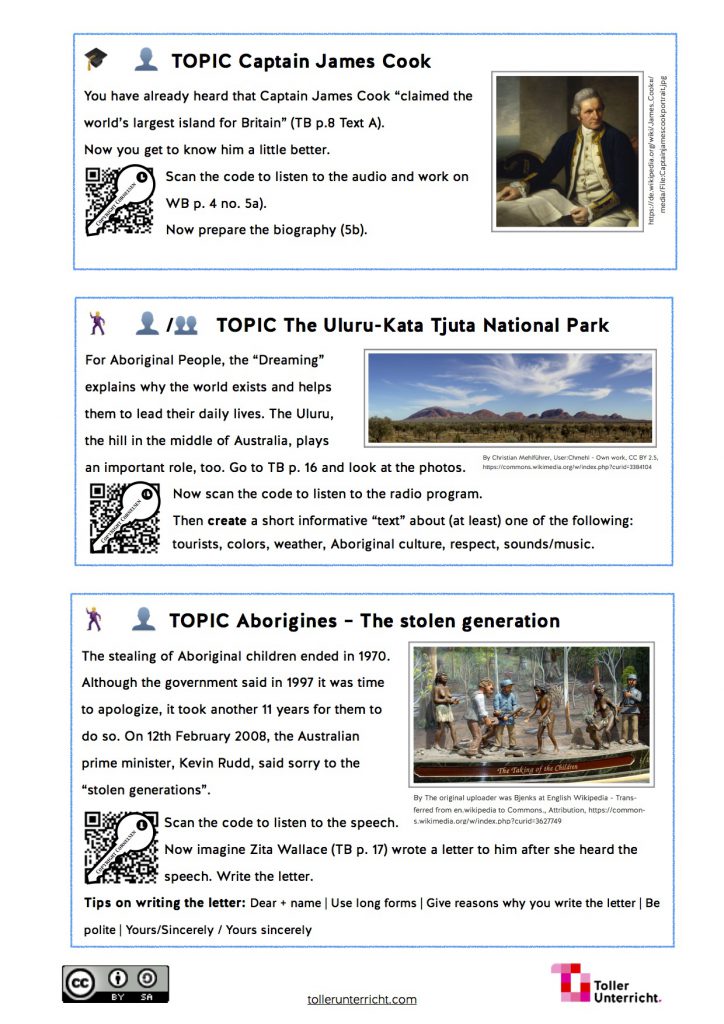To see and read the introduction first, click here.
The book we use in year 9 is Cornelsen English G21 A5A. “TB” stands for Textbook, “WB” for Workbook.
Lesson 2: Mindmap + Argumentative Writing
- Jigsaw Puzzle: Facts about Australia (TB, pp. 8-9)
- Quiz: WB p. 4 no. 4
- Adding information on mindmap → Present some: What have we learned about Australia so far?
- What is a “station”? big farm
→ example: Jeannie at sheep station (TB p. 10)
→ reading, argumentative writing (no 2b)
→ REMEMBER steps! (we practiced argumentative writing in another unit very thoroughly)
Lesson 3: Project Work
Note: For this project (and some more in my other subjects 😉) I borrowed some iPads from the local educational media center. I had 16 iPads, one MacBook Air and even an Apple TV for eight weeks – I was even lucky to be able to have them another four weeks since no one else reserved them, hihi.
Students work on their own on the first part of their Australia project. I included these “lessons” every now and then so that we have a little mix of methods, teaching/learning arrangements.

See below to find the worksheets with the activities as PDF.
Lesson 4: The Aboriginal People of Australia I
Note: You should book a computer room for this lesson OR have tablets, smartphones etc. ready for use.
- Foto (Link): What do you see? What is special?
- Do you know anything about the Aborigines?
- They have a special understanding of the world and the origins of it, called “The Dreaming”
→ TB p. 16 The Dreaming
→ read out loud + read along - Web-Unit in pair work (computer room) → cornelsen.de/wu_dreaming
- PRESENTATION
Lesson 5: The Aboriginal People of Australia II
- Foto (Link): What do you see? What is different about them?
- These kids were really stolen from their homes, so people call them the “stolen generation”. What do you associate with that phrase?
- TB p. 17 no. 3: read text, talk about it (b)
- Grammar practice: TB pp 18-19 P1, P3-P5
- Homework: WB p. 8 no. 13, p. 10 no. 17, 18
Lesson 6: Project Work
Note: For this project (and some more in my other subjects 😉) I borrowed some iPads from the local educational media center. I had 16 iPads, one MacBook Air and even an Apple TV for eight weeks – I was even lucky to be able to have them another four weeks since no one else reserved them, hihi.
Students work on their own on the first part of their Australia project. I included these “lessons” every now and then so that we have a little mix of methods, teaching/learning arrangements.

See below to find the worksheets with the activities as PDF.
TIP: For the mini project “Magic of Australia” I included a sixth topic “Sports in Australia”. I simply used the questions on p. 2 of the free “Webcode Material” and printed them on sticky notes. I asked students to put them in their books (as you can see in the picture). Here‘s a tutorial on how to print on sticky notes.
Lesson 7: German immigration in Australia
Note: You should book a computer room for this lesson OR have tablets, smartphones etc. ready for use.
- Foto (Link) → Describe
- Let’s find out a little more about it
→ TB p. 11 P1 - Together with your partner, have a look at at least five stories of migrants of German cultural background
→ tinyurl.com/germansinaustralia
→ the basis for this part is Task 3 from the web unit by Cornelsen; I printed the tinyurl link, the questions and some unknown words on a worksheet for my students - Give an oral presentation of what you found out
Lessons 8-9: Project Work
Note: For this project (and some more in my other subjects 😉) I borrowed some iPads from the local educational media center. I had 16 iPads, one MacBook Air and even an Apple TV for eight weeks – I was even lucky to be able to have them another four weeks since no one else reserved them, hihi.
Students work on their own on the first part of their Australia project. I included these “lessons” every now and then so that we have a little mix of methods, teaching/learning arrangements.



Here are all activities as a PDF document. I could not include the real QR-Codes since they refer to material by Cornelsen.
